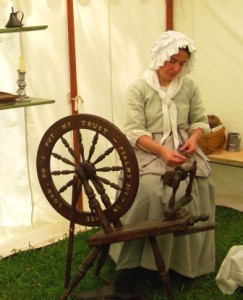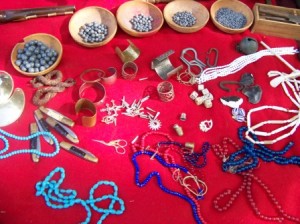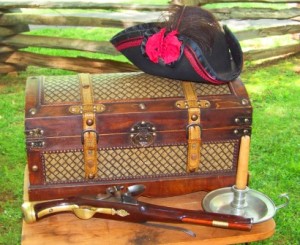Ninety Six has a colorful history dating back to early colonial times when a settlement began at the 96th milepost from Keowee Indian village, on a trail used by traders with the Indians. A small store, run by Robert Goudy supplied traders with such items as rum, sugar, and gunpowder, is on record as existing as early as 1730. Most likely, Ninety Six received its name when Indian maiden Issaqueena (Cateechee), rode her horse, ninety six miles from Keowee, the capital of the Cherokee nation to the outpost to warn of impending war by the Indian natives. Today historic Issoqueena Falls, an SC State Park, where Issoqueena hid from her tribe attackers, can be visited in the upstate Clemson area.
The SC colony’s royal governor, James Glen, came to Ninety Six to have a ceremonial conference with the Cherokee “emperor” in 1746. The governor had a military escort and “about 50 gentlemen,” according to the land journal of his trip. This helped to quell some of the land disputes. As settlers continued to develop the area, the colonists soon established “96” as the first court in the Upstate region, with the only other being in Charleston, SC.

The first land battle of the American Revolutionary War in the South was fought at Ninety Six November 19-21, 1775, setting an American Revolutionary War record. About 500 Patriots hastily built a rustic fort of fence and rails and bales of straw, dug a well inside, and fought an attack from a much larger force of Tories. There were casualties on both sides, the first blood shed for American independence in this region. The battle ended in a formal truce.
Considered a key backcountry outpost, British forces later fortified Ninety Six, building a stockade around the village and at one corner constructing a star-shaped fort of massive earthen embankments. Inside Star Fort, the British held out for 28 days in May through June 1781 against a siege by General Nathaniel Greene and his American Continental Army. The Americans started a tunnel through which they planned to blow up Star Fort, but the Redcoats under Lord Rawdon marched from Charleston to aid the garrison, and General Greene had to withdraw before superior numbers. Today the siege is listed as the longest in the American Revolutionary War, setting a second record for the Ninety Six Star Fort National Park.
Embankments of the star-shaped fort and some 35 feet of the tunnel have survived in the forest for over 200 years. Both the earthen fort and the tunnels are the only ones remaining anywhere today. Archeologists uncovered marks of stockades, Fort Ninety Six, which protected pioneers against Indian attacks in 1760, and traces of more Colonial fortifications. Also uncovered were the foundation corners of the Colonial courthouse, built in the same style as the existing one left in Charleston, SC along with a jail, or gaol as it was known, built around 1770. The village was the center of the Ninety Six Judicial District established in 1769. The district encompassed 14 modern South Carolina counties.
The site is now owned by the National Park Service because of its important history. Congress authorized the creation of the Ninety Six National Historic Site in 1976. The park is located on South Carolina Highway 248, two miles south of the present town of Ninety Six.

Though General Greene and his army had departed, the British soon abandoned the village when they left in the summer of 1781, burning it as they withdrew. Many Tory families followed the troops to Charleston, SC others left to venture to Nova Scotia. In 1783, the legislature approved the building of a new town of Ninety Six, two hundred yards west of the burned town. The town flourished with homes, a church, stores, taverns, a newspaper, resident lawyers, doctors, and artisans.
In 1785, the South Carolina legislature established the College of Cambridge in Ninety Six. The school was a college preparatory academy for young white men. The citizens voted to change the village name from 96 to Cambridge in its honor. In 1787, the South Carolina General Assembly renamed the old Ninety Six district judicial center Cambridge, but the name Ninety Six (96) persisted. Cambridge lost its status as a courthouse town with the formation of new districts in 1800. The village of Cambridge declined, eventually becoming a ghost town.
Almost the entire northwestern corner of South Carolina was part of the Ninety Six District and the political, legal, cultural and social activities centered on the upcountry courthouse until 1800. The large area of the Ninety Six District was sufficiently populated to make up twelve political districts, stretching from present-day Aiken County through Spartanburg County. The town of Ninety Six was on the border of the newly formed districts of Abbeville and Edgefield, but mostly Abbeville.

The village was renamed back to Ninety Six in 1852 and shifted two miles eastward when the Greenville-Columbia Railroad was constructed.
During the 1840s, agrarian life around Ninety Six changed from self-sufficient farmsteads to the production of the cash crop “king” cotton. Some grew wealthy and managed large plantations and others continued with their farmsteads.
The Village of Ninety Six was chartered by an act of the General Assembly of South Carolina on January 28, 1869.
After several attempts to create a “Ninety Six County,” finally Ninety Six lost out to the larger railroad town, Greenwood, to be the county seat of the new Greenwood County, which was formed in 1897 from sections of Edgefield and Abbeville counties.
Qualified voters in the Village of Ninety Six elected to surrender its Charter in favor of incorporation. The official date of incorporation is May 27, 1905, the 129th year of the Independence of the United States of America, and it was signed by J.T. Gantt, Secretary of State for South Carolina.
Over the years, Ninety Six prospered because of its local industries such as the Ninety Six Cotton Mills, Hansen Brick Company (formerly Southern and Richtex), Star Fort Cannery, and the Ninety Six Oil Mill. Due to the decline of textile mills and other industries, residents have sought employment in nearby towns. However, many still enjoy the quaint small-town quality of life Ninety Six still offers.
Most of the original buildings from the 1800s to early 1900s still exist in the Town Square, giving the Town a beautiful historical look.